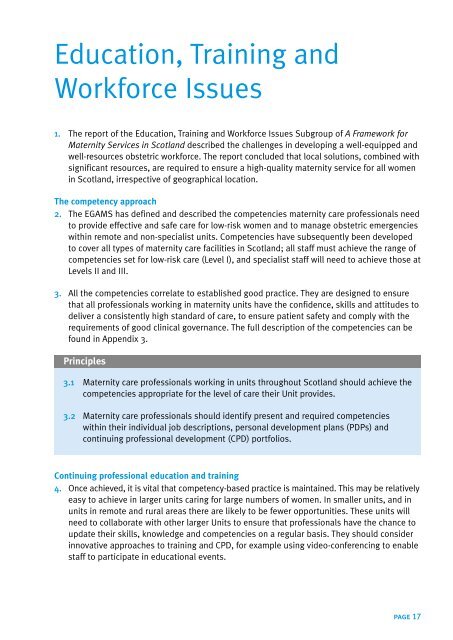Implementing A Framework for Maternity ... - Scottish Government
Implementing A Framework for Maternity ... - Scottish Government
Implementing A Framework for Maternity ... - Scottish Government
Create successful ePaper yourself
Turn your PDF publications into a flip-book with our unique Google optimized e-Paper software.
Education, Training and<br />
Work<strong>for</strong>ce Issues<br />
1. The report of the Education, Training and Work<strong>for</strong>ce Issues Subgroup of A <strong>Framework</strong> <strong>for</strong><br />
<strong>Maternity</strong> Services in Scotland described the challenges in developing a well-equipped and<br />
well-resources obstetric work<strong>for</strong>ce. The report concluded that local solutions, combined with<br />
significant resources, are required to ensure a high-quality maternity service <strong>for</strong> all women<br />
in Scotland, irrespective of geographical location.<br />
The competency approach<br />
2. The EGAMS has defined and described the competencies maternity care professionals need<br />
to provide effective and safe care <strong>for</strong> low-risk women and to manage obstetric emergencies<br />
within remote and non-specialist units. Competencies have subsequently been developed<br />
to cover all types of maternity care facilities in Scotland; all staff must achieve the range of<br />
competencies set <strong>for</strong> low-risk care (Level I), and specialist staff will need to achieve those at<br />
Levels II and III.<br />
3. All the competencies correlate to established good practice. They are designed to ensure<br />
that all professionals working in maternity units have the confidence, skills and attitudes to<br />
deliver a consistently high standard of care, to ensure patient safety and comply with the<br />
requirements of good clinical governance. The full description of the competencies can be<br />
found in Appendix 3.<br />
Principles<br />
3.1 <strong>Maternity</strong> care professionals working in units throughout Scotland should achieve the<br />
competencies appropriate <strong>for</strong> the level of care their Unit provides.<br />
3.2 <strong>Maternity</strong> care professionals should identify present and required competencies<br />
within their individual job descriptions, personal development plans (PDPs) and<br />
continuing professional development (CPD) portfolios.<br />
Continuing professional education and training<br />
4. Once achieved, it is vital that competency-based practice is maintained. This may be relatively<br />
easy to achieve in larger units caring <strong>for</strong> large numbers of women. In smaller units, and in<br />
units in remote and rural areas there are likely to be fewer opportunities. These units will<br />
need to collaborate with other larger Units to ensure that professionals have the chance to<br />
update their skills, knowledge and competencies on a regular basis. They should consider<br />
innovative approaches to training and CPD, <strong>for</strong> example using video-conferencing to enable<br />
staff to participate in educational events.<br />
page 17

















